Dec 23, 2025
Dec 23, 2025
by Tarun Rana
Saga of the making of Howrah Bridge, @75 now
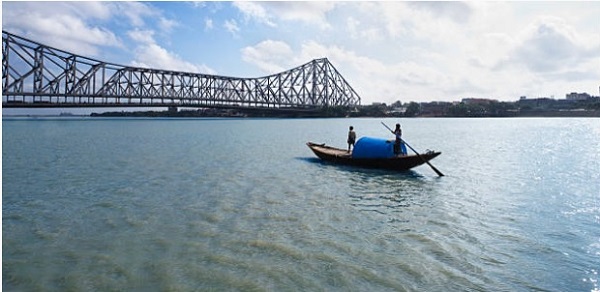
Image (c) Gettyimages.com
The Howrah Bridge connecting the twin cities over the river Hoogly, the name by which the Ganges is known in this part of Bengal, has for the last seventy five years become an inseparable part of Calcutta, the very ethos of the city long after it ceased to be the capital of British, presently Independent India. The steel bridge spanning the river for 1500 feet, - the sixth largest of its sort in the world - as it glistens with the rays of the morning sun and thus welcomes the wearied travellers returning from a tiring, and perhaps troublesome trip, or as it mellows in the moonlight, bidding adieu to its netizens in a tearing hurry to leave the city for a breath of fresh air and in search of pastures anew – is a wonder of engineering excellence, and at the same time, a poet, a painter, a photographer’s object of beauty.
Cinema, the new media when the bridge was thrown open way back in 1943 or TV, its latest and shortened version, go ga ga in its portrayal of romantic scenes, scenes of sadness, separation or to portray the essence of a variegated, cacophonic city life against the backdrop of a massive, stolid steel structure.
Much as we might poeticise the wonder of a gigantic steel bridge, seemingly hanging in the air, do we know the long history behind its erection/ creation? That there was a bridge earlier, which it replaced, more than seventy years after its existence?
The necessity of having a bridge over the river was long being felt by the East India Company rulers, more so soon after the introduction of railways in 1854 and the establishment of a station on the other side, but the actual work started with the enactment of an Act in 1871 empowering the Lieutenant –Governor to have the bridge built with government capital.
And a contract was accordingly entered into with Bradford Leslie (1831-1926), a bridge expert and then Chief Engineer to the East Indian Railways, who designed an unusual floating pontoon bridge. The different portions of the bridge after being constructed in England was sent out to Calcutta for assembly.
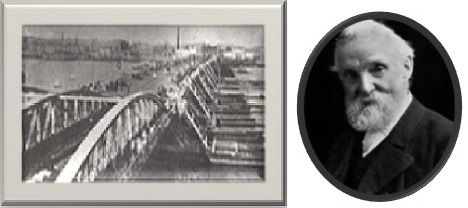
The bridge was thus completed in the October of 1874 and it was thrown open for traffic.1528 feet long between abutments, with a 48 feet wide roadway for carriages and a 7 feet wide footpath on both sides, this floating bridge was unique, as its middle section could be raised so as to allow movement of vessels up stream.
This, however, caused considerable delays also, as the bridge was virtually closed to traffic and passengers during the time two of its arms were being uplifted.
At the turn of the next century, it being found inadequate to meet the growing volume of men and vehicles, thoughts of having a new bridge according to the latest design were mooted.
In the meantime, Bradford Leslie had been knighted for having successfully constructed in 1887 the Jubilee Bridge for the trains to cross over the Hoogly from Naihati to Bandel – the first permanent crossing across the river and named ‘Jubilee’, as it was inaugurated during the Jubilee celebrations of Queen Victoria’s fifty years of reign.
It is the same year that Sir Bradford Leslie had to return to his home in England. While In India, he had lost his wife, three daughters and a son in law. The malaria menace being so horrifying, Leslie decided to return with his two orphan grand- daughters.
Tragedy dogged his footsteps. On the voyage ,due to a ship wreck off the coast of Corsica, while taking to safety one of his grand- daughters, he fell and injured his knee , the trouble accentuated by a later accident with a bi- cycle plaguing him till his death.
However, he continued to work; in 1899, Sir Leslie came on a brief visit to India to discuss a replacement of his straddling bridge and in 1918, then 88, a new design, an improvement of the older version, - a floating twin pontoon bridge – with lesser time taken for the opening of the middle section, was submitted by him.
The Government of Bengal, in the meantime, had appointed Sir Basil Mott, the President of Institution of Civil Engineers, London and an expert in the making of modern bridges, to recommend the most suitable type required for a busy metropolis like Calcutta. He came out with the proposal for a single span arch bridge.

In the face of such conflicting proposals and in view of the complexity of the problem involved, the matter was referred to an expert Committee of Engineers on November 04,1921 presided over by Sir Rajendra Nath Mookerjee, K.C.I.E the other members from Bengal-Nagpur Railways, Calcutta Port Trust , Calcutta Corporation and the high official of the rank of the Secretary from the Government of Bengal, being all Britishers or Europeans.
Who is this Sir Rajendra Nath Mookerjee? How could a Bengali, an Indian head a Committee of Engineers constituted by foreigners all? Could he be the same man – Sir R. N. Mookerjee after whom the road, Mission Row - leading to Dalhousie Square from the Eastern direction is now named?
Yes, he is no other than Rajendranath, then Senior Partner of Martin & Co – the erstwhile Indo British conglomerate with its headquarters in Lal Bazar opposite Calcutta Police Head Office. The Martin Burn building – Burn & Co. another big British concern which Sir R.N. acquired in 1927 , the company becoming known as Martin Burn after the amalgamation in 1946 during his son, Birendranath’s regime.
A village boy hailing from the suburbs of North 24- Parganas, close to Basirhat, one who lost his father early at the age of six and being brought up by his mother and the elders of the joint family he belonged to, Rajendranath (June 23,1854 – May 15,1936) plodded his way up to a dizzying height.
On December 28,1921, only a few days after the constitution of the said Committee of Engineers, - the day the Victoria Memorial Hall was being inaugurated by the Prince of Wales, in the presence of an enthusiastic crowd and amidst a flourish of trumpets and boom of hundred guns, with ‘a jewelled key presented by Sir R. N. Mookerjee, on behalf of the contractors’ – Martin & Co.
On this exalted occasion, His Excellency the Governor of Bengal spoke thus:
… To Messers Martin & Co., the Contractors, and to their distinguished head, Sir Rajendra Nath Mookerjee, K.C.I.E. we must pay a tribute of admiration and gratitude for the manner in which they have carried through the tremendous task which has devolved upon them in giving material shape to Sir William Emerson’s brilliant design.
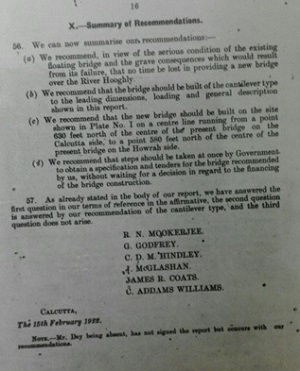 On February 15, 1922, the Mookerjee Committee of Engineers unanimously recommended in its Report the construction of a cantilever bridge as per the design, ‘leading dimensions, loading and general descriptions shown‘ immediately in view of the seriousness and gravity of the situation involved.
On February 15, 1922, the Mookerjee Committee of Engineers unanimously recommended in its Report the construction of a cantilever bridge as per the design, ‘leading dimensions, loading and general descriptions shown‘ immediately in view of the seriousness and gravity of the situation involved.
The work, however, finally started after Rajendranath’s demise and continued even during the turbulent days of the Second World War. Completed in 1942, the bridge – a marvel of engineering excellence – was thrown open on February 03, 1943 without much fanfare because of the threat perception. Only a tram crossed the bridge on that momentous day.
Later on, Sir R.N. recalled a significant meeting in his London Office after the submission of the report of the Committee. A patriarch in his nineties, his head covered with a mass of dishevelled white hair and a limping gait, his wife, three daughters and one son in law all deceased due to hostile weather during his stay in India , an almost archetypal King Lear figure , arguing at first on the great merit of the design of twin pontoon type of bridge; pleading later to the person who he had given the necessary break of his career as an enterprising business man in the Palta Water Works – not to spoil the good name of his benefactor.
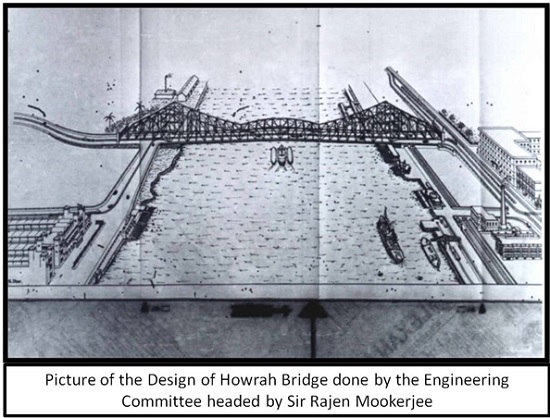
Let SirBradford Leslie be remembered ever in India through the construction of a floating bridge of the improved type - was the earnest plea of a nonagenarian. But Rajendranath, almost acceding to the urgent request of his erstwhile mentor, retracted at the last moment in consideration of the demands of the modern day engineering solution for a growing and pulsating economy of a teeming city.
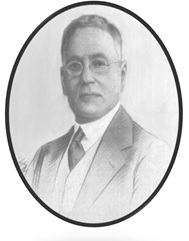 Let’s salute the great Bengali Engineer on the Seventy Fifth birthday of the Howrah Bridge for his vision of the needs of a bustling metropolis. The bridge which not only links two cities, two architectural marvels too - one an imposing, stately, marble white, regal memorial built in the western mould; the other, an ochre coloured temple of high devotion dedicated to Sri Sri Ramakrishna at Belur, Howrah; an oriental monument representing fusion of all faiths, construction of which was begun by Rajendranath’s company at the last year of his life and completed after his demise in 1938.
Let’s salute the great Bengali Engineer on the Seventy Fifth birthday of the Howrah Bridge for his vision of the needs of a bustling metropolis. The bridge which not only links two cities, two architectural marvels too - one an imposing, stately, marble white, regal memorial built in the western mould; the other, an ochre coloured temple of high devotion dedicated to Sri Sri Ramakrishna at Belur, Howrah; an oriental monument representing fusion of all faiths, construction of which was begun by Rajendranath’s company at the last year of his life and completed after his demise in 1938.
18-Mar-2018
More by : Tarun Rana